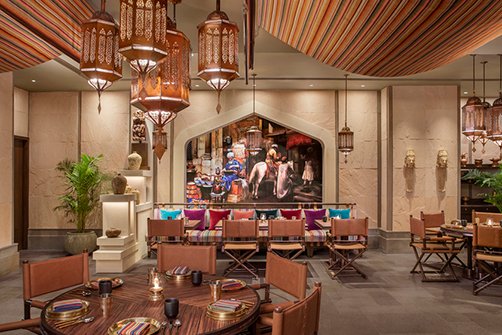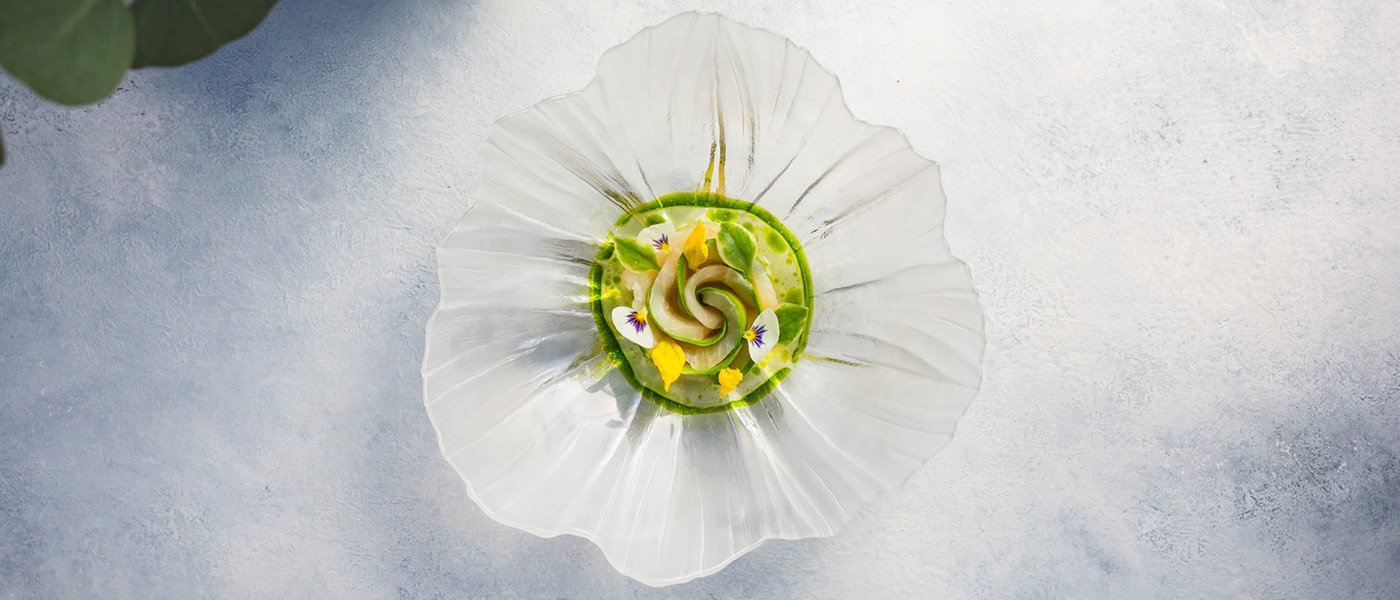Hong Kong’s best new restaurants serve up the world on a plate
Kee Foong describes the exotic culinary adventures he’s taken recently without a single plane ticket.
Chaat

Manav Tuli has a confession to make: “I thought maybe I had done the wrong thing coming to Hong Kong,” he admits, having given up his position as head chef at Tamarind in London—one of only a handful of Michelin-starred Indian restaurants worldwide—to land in a city racked by months of protests, followed by Covid-19. But then the coronavirus struck the U.K., forcing it into lockdown, which Hong Kong avoided, “and I realized I was lucky, and was in the right place at the right time.”



Tuli spent eight months preparing for the opening of Chaat (chaat.hk) at the Rosewood Hong Kong, and the ensuing clamor for socially distanced tables blew him away. Chaat, which means “to lick,” also refers to the myriad savory snacks sold from push carts and roadside stalls across India—as much a part of life there as music, dancing and cricket. “Before you have chaat, you should be salivating just talking about it,” Tuli tells me over lunch, his face lighting up at the memory of his favorite childhood food. To understand the fuss, order the raj kachori, fist-sized pastry shells stuffed with potato, lentils, chickpeas and spices, then topped with tamarind, mint chutney, yogurt and a glitter of pomegranate seeds. “Crispy, sweet, sour, spicy, tangy—it’s everything chaat should be,” he enthuses.

Dish after dish of his street-food-inspired menu is superb: flaky cones of lamb samosa; buttery flatbread flecked with bone marrow; beef short rib and grouper fish from the tandoor that fall apart at the touch of a fork; briyani rice billowing with aromatic puffs of steam when the server cuts open the pastry lid; and a zingy pork-cheek vindaloo where the chili catches me by stealth. Travel to India may be out for now, but I only have to cross Victoria Harbour for a delicious sampling of the subcontinent.
Hansik Goo

Chaat is one of several restaurants headed by acclaimed international chefs that have bravely opened amid the pandemic, raising the culinary bar and bolstering Hong Kong’s reputation as a global food capital, while giving grounded diners a taste of the exotic. Another is Hansik Goo, the first venture outside of South Korea by chef Mingoo Kang, whose Michelin-two-starred Mingles also ranks as Korea’s best restaurant on the Asia’s 50 Best list. Border closures meant that Kang was absent for the launch, though fortunately, his team from Seoul arrived just before the travel ban, and he supervised them via video calls.

“My cooking represents a variety of Korean food, from royal cuisine to temple cuisine and home cooking,” Kang says when we meet (he was able to visit Hong Kong soon after Hansik Goo opened). “Many people think of Korean food as barbecue, but it’s very seasonal, with lots of respect for ingredients” he explains, adding: “Only some dishes are spicy, but many are not; they are mild.”

Yukhoe. Courtesy of Hansik Goo.
My first bites of his tasting menu reveal it to be ethereal, too, with a basket of crisps made with seaweed, fish skin, perilla leaf and chili coated in glutinous rice paste crackling in my mouth. Yukhoe—Korean-style steak tartare—plays on the tongue, thanks to the addition of jang, fermented pastes integral to Korean cuisine, and bibim-guksu is an umami dream of cold noodles coated in a piquant gochujang paste, served alongside barbecued pork and cabbage kimchi.
Ando

Steps away from Hansik Goo is Ando, Agustin Balbi’s culinary love letter to his Argentinian, Spanish and Italian roots, as well as to his six years in Japan, where he honed his skills in some of Tokyo’s top kitchens, learned the language, and met his wife. It’s an arc that translates into a unique blend of East and West, one not fixed on a single place. “We’re trying to get out of a geographical location, so it’s not one or the other, Japan or Spain, but a restaurant that tells my story,” Balbi says. He strives to be true to the flavors of each cuisine, while using ingredients and techniques drawn from his travels.

Each dish on Ando’s tasting menu poetically references a part of Balbi’s life. Partir represents his departure from Argentina to Japan, and comes in the form of seasonal sashimi. Rias del Jardin recalls weekends in the garden as family and friends gathered for asados (grilled meats), and Sin Lola, or “without Lola,” pays tribute to his Spanish grandmother. This dish of arroz caldoso encapsulates Balbi’s life and philosophy, a thick, soupy delight of rice cooked in chicken and chorizo, clam and abalone stocks. It’s a traditional dish that crosses cultures with the use of soy, mirin and sake, at once creative yet so comforting that it feels like I’m snuggled in a warm blanket on a cold winter’s day.
Mono

On a different trajectory is Balbi’s friend and fellow South American, Ricardo Chaneton, who hails from Venezuela. Chaneton was head chef at Mirazur in France, currently ranked No. 1 on the World’s 50 Best Restaurants list, before moving to Hong Kong in 2016. Following time at Petrus in the Island Shangri-La, he went out on his own early this year with Mono, which quickly evolved from contemporary French to a beacon for innovative Latin American cuisine.

“South America is such a beautiful continent, with so much history, culture, flavor and knowledge, and I want to represent that,” says Chaneton, who credits his diners with encouraging him to explore his heritage. Mono’s ambitious tasting menu changes regularly, but may include homemade quinoa sourdough bread, luscious morcilla (blood pudding) crème brûlée, or 70-percent Venezuelan dark chocolate mousse that is the perfect bittersweet ending.


Courtesy of Mono.
Star of the show however, is that most complex of Mexican sauces, mole. It’s alchemy by fire as Chaneton dramatically takes a blow torch to mortar and pestle and when it’s smoking hot, mixes together a heady blend of chili, spices, nuts, aubergine, cocoa and chocolate. On one occasion, I have the mole with perfectly pink pigeon, on another, with stuffed quail, and each time it’s a contender for dish of the year.
Crown Super Deluxe

Theatrics are central to the experience at Crown Super Deluxe, a fantasy teppanyaki joint that veers on gilded bordello. The interiors—meant to evoke 1960s Tokyo glamour—are a riot of deep purple carpet, gold onyx counters, mustard velvet armchairs and carved lattice screens. Overseeing the sizzling hotplates are husband and wife team Toru Takano and Ami Hamasaki, masters of multi-tasking as they carve up live lobster, fry fragrant garlic chips and sear premium Wagyu beef, all while entertaining voyeuristic diners.


“Teppanyaki is special because it is live cooking,” Takano says. “You can enjoy the sight, the sound, the smell, the flavor.” It’s also great fun, and following my meal I reflect on the year’s best new restaurants. Each reminds me of the joy of human interaction, fosters cultural understanding, tells stories we can connect with, and promises culinary adventure. They transport the mind and palate without the need for a passport, or having to get on a plane.
5 More International Hops in Hong Kong
Chef Andrea Zamboni trained with Gualtiero Marchesi, described as the founder of modern Italian cuisine, and worked at Michelin-three-starred Otto e Mezzo Bombana in Hong Kong. He now heads up Aria, a suave space with knockout city views, but it’s Zamboni’s deft cooking that commands attention. His scampi and foie gras and risotto with Prosecco are classics-in-the-making.
Hong Kong’s first upscale Burmese restaurant is a stylish introduction to this under-the-radar cuisine serving classics such as la pet thoke (tea leaf salad), wat thani (pork stew), and the national dish of mohinga noodles in catfish broth.
Chef Barry Quek has swapped fine dining to explore his Singaporean and Malaysian heritage in an upmarket food court, BaseHall. Only two mains are on the menu—nasi lemak, a fragrant coconut rice and fried chicken dish, and Nyonya laksa, a creamy coconut curry noodle with prawns and cockles—so order both.
Aussie chef Adam Cliff’s second Samsen is more than double the size of the original venue, with an expanded menu of Thai street-food favorites that includes superb khao soi curry noodles, crab omelette and a roti flatbread dessert with banana, Nutella and condensed milk.
It would be criminal to leave Cantonese off a list of new recommends. Yung’s Bistro delivers updated takes on roasted goose and other classic dishes made famous by its parent restaurant, the venerable Yung Kee, in a cool, contemporary setting.

